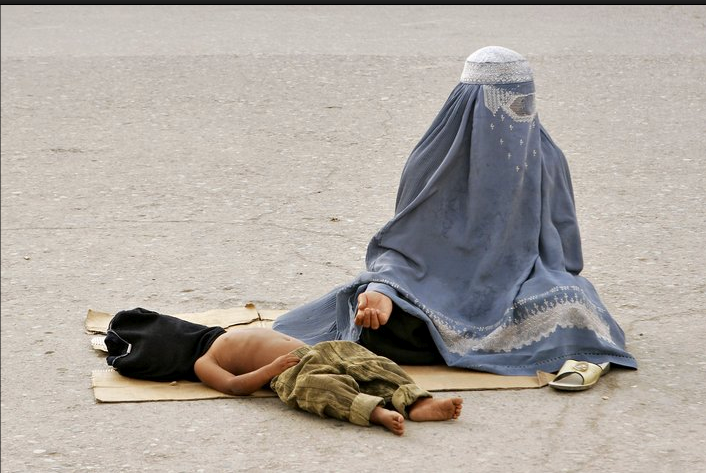This photograph is one I could write about for hours, and yet none of that could do justice to the image itself:
I’m not going to write for hours, but where to begin? The photograph combines in a single, compact image so much of the human condition: naked physical need, confinement, dependency, vulnerability, shame, desolation, death. Surely this is the truth of the image.
And perhaps we should stop there. It is a stunning, haunting, damning image. Leave it alone. Think about the carnage and suffering being wrought in the world, about how these two human beings without status or money are caught between two civilizations, one medieval and the other mechanized, and excluded and abandoned by each of them. Think anything you want, just don’t turn away, yet another abandonment.
But it’s not that simple. Read the caption: “A woman begs as she lets her son sleep with his head covered to attract attention in Kabul, Afghanistan.” How the writer knew her motive for covering the child’s head, I don’t know; it could also be covered to help him sleep in the sunlight. And perhaps this caption exemplifies the abyss between image and text, between the mad, raw truth of an image and the linguistic shroud being applied to keep it tame. Perhaps, but the fact is the boy is asleep, not dead. In fact, he looks pretty healthy. And his pants look like they came from the mall and not long ago either. Does she really need to beg, or is this just a gambit to pick up some loose change when the foreigners walk by?
Perhaps there is a double manipulation, one by her and the other by the photographer. We’ve written at this blog about how the burqa (she is wearing the Afghani variant called the Chadri) is a traumatic violation of Western norms of visibility, and of how images of feet and hands (accompanied by virtual decapitation) are techniques for creating emotional meaning and intensity. And that empty desert background is part of a city, not some alien moonscape. Worse yet, the photograph is austerely beautiful and so perhaps aestheticizing suffering. There also may be an orientalist appeal to the male gaze: the mystery of flesh revealed from underneath the restrictions of purdah. And one can go further down that road. The photograph seems to be a powerful witness to suffering and yet also a trap pulling one into a perversely pleasurable spectacle.
That’s where a lot of academic commentary would stop, but let’s look at it again. She is sitting on a piece of cardboard; that seems to undermine the idea that she is being opportunistic. This could well be her sole source of income, at best. Next, and this is the punctum (the term comes from Roland Barthes, Camera Lucida) in my experience of the photo, look at her shoe. What is it doing there? It could be a signal, it could be that she was more comfortable sitting on her bare foot, we don’t know. It looks like an ordinary sandal that could have come from Walmart, and that may bring the manipulation thesis back in, but I see it differently. The shoe is a sign of several things that further complicate the meaning of the photograph. First, this odd, ordinary item of apparel reminds me that her culture is not medieval but, like all culture, hybrid. Second, she is not a symbol but someone who acts, however limited her sphere of action, and acts practically by adjusting, dealing, making do. I’m not sure how, but somehow her mundane practicality challenges any metaphysical exclusion or aesthetic regime. That shoe is a thread connecting to other threads of personal and then social activities that can become a web of associations, obligations, actions. Thus, she is not entirely cast out but rather still within her society, and ours.
Photograph by Farzana Wahidy/Associated Press; caption from the Washington Post Day in Photos, May 8, 2007. For a summary of Giorgio Agamben’s concept of “bare life,” read here. If you want to see another (consistent) level of meaning, read the story in Genesis 21 of Hagar and Ishmael.

She is not waiting for foreigners to walk by. Foreigners don’t walk by. They are driving in there SUV’s and bodyguards. They are too busy going from one party to another with the elite of Afghanistan. This image captures the true image of Kabul today. When I was a child growing up in kabul you did not see this. I visit Kabul often today. I see little children working, cleaning shoes or collecting trash for fire wood. I have a 5 year old daughter and it would kill me if that were to happen to her. No matter how strong you are. Visiting Kabul will make you cry. Its very sad what Afghanistan has become. War is hell!
[…] Frankly, I don’t think the scene needs that kind of help. (See, for example, the photograph here.) That said, I have to admit that this image has a metaphoric resonance that might be missed if we […]